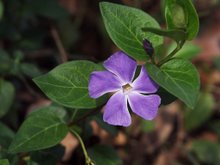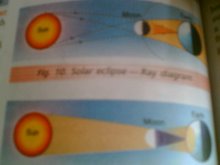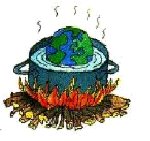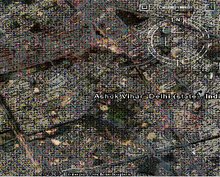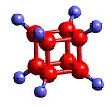There exists a great diversity and complexity among the microorganisms.
5 Groups:
(i)Bacteria
(ii)Protozoa
(iii)Algae
(iv)Fungi
(v)Viruses
Monday, 16 May 2011
significance of lactobacillus in the formation of curd
What is the significance of lactobacillus in the formation of curd?
Lactobacillus is a kind of bacteria which can convert a sugar into an alcohol and then into an acid by means of anaerobic respiration.
Milk contains a sugar called lactose, a disaccharide (compound sugar) made by the glycosidic bonding between glucose and glactose (monosaccharides).
When milk is heated to a temperature of 30-40 degrees centigrade and a small amount of old curd added to it, the lactobacillus in that curd sample gets activated and multiplies. These convert the lactose into lactic acid, which imparts the sour taste to curd.
Lactobacillus is a kind of bacteria which can convert a sugar into an alcohol and then into an acid by means of anaerobic respiration.
Milk contains a sugar called lactose, a disaccharide (compound sugar) made by the glycosidic bonding between glucose and glactose (monosaccharides).
When milk is heated to a temperature of 30-40 degrees centigrade and a small amount of old curd added to it, the lactobacillus in that curd sample gets activated and multiplies. These convert the lactose into lactic acid, which imparts the sour taste to curd.
MICROORGANISMS : FRIENDS OR FOES?
Friendly Microorganisms
Microorganisms are used for various purposes. They are used in the preparation of curd, bread and cake. They have been used for the production of alcohol since ages.
They are also used in cleaning up the environment. For example, the organic waste (vegetables peels, remains of animals, faeces etc.) are broken down in to harmless and usable substances by bacteria.
Making curd and Bread
Curd contains several microorganisms. Of these the bacterium Lactobacillus promotes the formation of curd. It multiplies in milk and converts it into curd. Bacteria also involved in the making of cheese, pickles and many other food items.
Yeast reproduces rapidly and carbon dioxide during respiration bubbles of the gas
Fill dough and increase its volume. This is the basis of the use of yeast in baking industries for making breads, pastries and cakes.
Commercial Use of Microorganism
Microorganisms are used for the large scale production of alcohol, wine and acetic acid (vinegar). Yeast is used for commercial production of alcohol and wine. For this yeast is grown on natural sugars presents in grains, barely, wheat, rice, crushed fruit juices, etc.
This is the smell of alcohol as sugar has been converted into alcohol by yeast. This process of conservation of sugar into alcohol is known as fermentation.
Medicinal use of Microorganism
Whenever we fall ill the doctor may give some antibiotics such as penicillin. The source of this medicine is microorganism. These medicines kill or stop the growth of the disease causing microorganism such medicines are called antibiotics. Streptomycin, tetracycline is some of the commonly known antibiotics which are made from fungi and bacteria. The antibiotics are manufactured by growing specific Microorganism and are used to cure a variety of disease.
Vaccine
When a disease carrying microbe enters our body, the body produces antibodies to fight the invader. The body also remembers how to fight the microbe if enters again. So if the dead or weakened microbes are introduced in a healthy body, the body fights and kills them by producing suitable antibodies. This is how a vaccine works. Several disease including cholera, tuberculosis, smallpox and hepatitis can be prevented by vaccination. These vaccinations are made up form Microorganism to protect humans and other animals from several diseases.
Increasing Soil Fertility
Some bacteria and blue green algae are able to fix nitrogen from the atmosphere to enrich soil with nitrogen and increase its fertility. These microns are commonly called biological nitrogen fixers.
Cleaning the Environment
Microorganisms can be used to degrade the harmful and smell substances and thereby clean up the environment.
So we can say that microorganisms are friends of us in many ways.
Harmful Microorganisms
Microorganisms are harmful in many ways. Some of the Microorganisms cause disease in humans, plants and animals these disease causing microorganisms are called Pathogens. Some Microorganisms spoil food, clothing and even leather.
Diseases causing Microorganisms in Humans
Pathogens enter in our body through the air we breathe, the water we drink and the food we eat. They can also get transmitted by direct contact with an infected person or carried through an animal. These kind of microbal diseases are called communicable diseases as they spread from the infected persons for example common cold, chicken pox, tuberculosis and many more.
When a person suffering from common cold sneezes, fine droplets of moisture carrying thousands of viruses spread in the air. The virus may enter the body of health person while breathing. There are some insects and animals which act as carriers of disease causing microbes.
Diseases causing Microorganisms in Animals
Several microorganisms not only cause disease in humans and plants but also in other animals. For example, anthrax is a dangerous diseases caused by bacterium. Foot and mouth disease of cattle is caused by a virus.
Diseases causing Microorganisms in Plants
Several microorganisms caused disease in plants like wheat, rice, potato, sugarcane, orange and others. The disease reduces the yield of crop. They can be controlled by the use of certain chemicals which kill the microbes.
Food Poisoning
it can be due to consumption of food spoilt by some microorganisms. Microorganism that grow on our food sometimes produce toxic substances, these make the food poisonous causing serious illness and even death. So it is very important that we preserve food to prevent it form being spoilt.
So in this way we can say that Microorganism is harmful to us.
Microorganisms are used for various purposes. They are used in the preparation of curd, bread and cake. They have been used for the production of alcohol since ages.
They are also used in cleaning up the environment. For example, the organic waste (vegetables peels, remains of animals, faeces etc.) are broken down in to harmless and usable substances by bacteria.
Making curd and Bread
Curd contains several microorganisms. Of these the bacterium Lactobacillus promotes the formation of curd. It multiplies in milk and converts it into curd. Bacteria also involved in the making of cheese, pickles and many other food items.
Yeast reproduces rapidly and carbon dioxide during respiration bubbles of the gas
Fill dough and increase its volume. This is the basis of the use of yeast in baking industries for making breads, pastries and cakes.
Commercial Use of Microorganism
Microorganisms are used for the large scale production of alcohol, wine and acetic acid (vinegar). Yeast is used for commercial production of alcohol and wine. For this yeast is grown on natural sugars presents in grains, barely, wheat, rice, crushed fruit juices, etc.
This is the smell of alcohol as sugar has been converted into alcohol by yeast. This process of conservation of sugar into alcohol is known as fermentation.
Medicinal use of Microorganism
Whenever we fall ill the doctor may give some antibiotics such as penicillin. The source of this medicine is microorganism. These medicines kill or stop the growth of the disease causing microorganism such medicines are called antibiotics. Streptomycin, tetracycline is some of the commonly known antibiotics which are made from fungi and bacteria. The antibiotics are manufactured by growing specific Microorganism and are used to cure a variety of disease.
Vaccine
When a disease carrying microbe enters our body, the body produces antibodies to fight the invader. The body also remembers how to fight the microbe if enters again. So if the dead or weakened microbes are introduced in a healthy body, the body fights and kills them by producing suitable antibodies. This is how a vaccine works. Several disease including cholera, tuberculosis, smallpox and hepatitis can be prevented by vaccination. These vaccinations are made up form Microorganism to protect humans and other animals from several diseases.
Increasing Soil Fertility
Some bacteria and blue green algae are able to fix nitrogen from the atmosphere to enrich soil with nitrogen and increase its fertility. These microns are commonly called biological nitrogen fixers.
Cleaning the Environment
Microorganisms can be used to degrade the harmful and smell substances and thereby clean up the environment.
So we can say that microorganisms are friends of us in many ways.
Harmful Microorganisms
Microorganisms are harmful in many ways. Some of the Microorganisms cause disease in humans, plants and animals these disease causing microorganisms are called Pathogens. Some Microorganisms spoil food, clothing and even leather.
Diseases causing Microorganisms in Humans
Pathogens enter in our body through the air we breathe, the water we drink and the food we eat. They can also get transmitted by direct contact with an infected person or carried through an animal. These kind of microbal diseases are called communicable diseases as they spread from the infected persons for example common cold, chicken pox, tuberculosis and many more.
When a person suffering from common cold sneezes, fine droplets of moisture carrying thousands of viruses spread in the air. The virus may enter the body of health person while breathing. There are some insects and animals which act as carriers of disease causing microbes.
Diseases causing Microorganisms in Animals
Several microorganisms not only cause disease in humans and plants but also in other animals. For example, anthrax is a dangerous diseases caused by bacterium. Foot and mouth disease of cattle is caused by a virus.
Diseases causing Microorganisms in Plants
Several microorganisms caused disease in plants like wheat, rice, potato, sugarcane, orange and others. The disease reduces the yield of crop. They can be controlled by the use of certain chemicals which kill the microbes.
Food Poisoning
it can be due to consumption of food spoilt by some microorganisms. Microorganism that grow on our food sometimes produce toxic substances, these make the food poisonous causing serious illness and even death. So it is very important that we preserve food to prevent it form being spoilt.
So in this way we can say that Microorganism is harmful to us.
Friendly Microorganisms
The concept of ‘Friendly Microorganisms’ was developed by Professor Teruo Higa, from the University of the Ryukyus in Okinawa, Japan. He reported in the 1970s that a combination of approximately 80 different microorganisms is capable of positively influencing decomposing organic matter such that it reverts into a ‘life promoting’ process. Higa invokes a ‘dominance principle’ to explain the effects of his ‘Effective Microorganisms’. He claims that three groups of microorganisms exist: ‘positive microorganisms’ (regeneration), ‘negative microorganisms’ (decomposition, degeneration), ‘opportunist microorganisms’. In every medium (soil, water, air, the human intestine), the ratio of ‘positive’ and ‘negative’ microorganisms is critical, since the opportunist microorganisms follow the trend to regeneration or degeneration. Therefore, Higa believes that it is possible to positively influence the given media by supplementing with positive microorganisms.
Saturday, 7 May 2011
WHAT YOU CAN DO TO SAVE THE TIGERS
Here are some practical steps you can take to help save the tiger:
Spread the word:
Tell others that the tiger and its habitat are under threat and that they need our help. You can form forums (or join existing ones) on the web for discussions and exchange views on tiger conservation. Schools can become members of WWF-India’s NCI (Nature Club of India) and reach out to children. WWF-India can help you in this regard.
Be a responsible tourist:
The wilderness is to be experienced and not to be disturbed and polluted. Follow the forest department guidelines when visiting any wilderness area, tiger reserve in particular. As the saying goes ‘Don’t leave anything behind except foot steps, and don’t take anything except memories.
Voice your concerns with the policy makers:
If you are really concerned and feel that more needs to be done for tiger conservation, then write polite letters to the decision makers - the Prime Minister, the Minister for Environment and Forests or even your local MP.
Help prevent wildlife trade:
Say ‘NO’ to tiger trade by refusing to buy tiger parts and items prepared from tiger derivatives. Speak to tiger and wild ungulate poachers and persuade them to give up poaching. If you know of any information on poaching or trade of illegal wildlife, inform the local law enforcement agencies. You can also contact TRAFFIC- an organisation fighting the powerful poachers and pass on the information to them.
Reducing pressure on natural resources:
By reducing the use of products derived from forests, such as timber and paper.
Spread the word:
Tell others that the tiger and its habitat are under threat and that they need our help. You can form forums (or join existing ones) on the web for discussions and exchange views on tiger conservation. Schools can become members of WWF-India’s NCI (Nature Club of India) and reach out to children. WWF-India can help you in this regard.
Be a responsible tourist:
The wilderness is to be experienced and not to be disturbed and polluted. Follow the forest department guidelines when visiting any wilderness area, tiger reserve in particular. As the saying goes ‘Don’t leave anything behind except foot steps, and don’t take anything except memories.
Voice your concerns with the policy makers:
If you are really concerned and feel that more needs to be done for tiger conservation, then write polite letters to the decision makers - the Prime Minister, the Minister for Environment and Forests or even your local MP.
Help prevent wildlife trade:
Say ‘NO’ to tiger trade by refusing to buy tiger parts and items prepared from tiger derivatives. Speak to tiger and wild ungulate poachers and persuade them to give up poaching. If you know of any information on poaching or trade of illegal wildlife, inform the local law enforcement agencies. You can also contact TRAFFIC- an organisation fighting the powerful poachers and pass on the information to them.
Reducing pressure on natural resources:
By reducing the use of products derived from forests, such as timber and paper.
WHAT YOU CAN DO TO SAVE THE TIGERS
Here are some practical steps you can take to help save the tiger:
Spread the word:
Tell others that the tiger and its habitat are under threat and that they need our help. You can form forums (or join existing ones) on the web for discussions and exchange views on tiger conservation. Schools can become members of WWF-India’s NCI (Nature Club of India) and reach out to children. WWF-India can help you in this regard.
Be a responsible tourist:
The wilderness is to be experienced and not to be disturbed and polluted. Follow the forest department guidelines when visiting any wilderness area, tiger reserve in particular. As the saying goes ‘Don’t leave anything behind except foot steps, and don’t take anything except memories.
Voice your concerns with the policy makers:
If you are really concerned and feel that more needs to be done for tiger conservation, then write polite letters to the decision makers - the Prime Minister, the Minister for Environment and Forests or even your local MP.
Help prevent wildlife trade:
Say ‘NO’ to tiger trade by refusing to buy tiger parts and items prepared from tiger derivatives. Speak to tiger and wild ungulate poachers and persuade them to give up poaching. If you know of any information on poaching or trade of illegal wildlife, inform the local law enforcement agencies. You can also contact TRAFFIC- an organisation fighting the powerful poachers and pass on the information to them.
Reducing pressure on natural resources:
By reducing the use of products derived from forests, such as timber and paper.
Spread the word:
Tell others that the tiger and its habitat are under threat and that they need our help. You can form forums (or join existing ones) on the web for discussions and exchange views on tiger conservation. Schools can become members of WWF-India’s NCI (Nature Club of India) and reach out to children. WWF-India can help you in this regard.
Be a responsible tourist:
The wilderness is to be experienced and not to be disturbed and polluted. Follow the forest department guidelines when visiting any wilderness area, tiger reserve in particular. As the saying goes ‘Don’t leave anything behind except foot steps, and don’t take anything except memories.
Voice your concerns with the policy makers:
If you are really concerned and feel that more needs to be done for tiger conservation, then write polite letters to the decision makers - the Prime Minister, the Minister for Environment and Forests or even your local MP.
Help prevent wildlife trade:
Say ‘NO’ to tiger trade by refusing to buy tiger parts and items prepared from tiger derivatives. Speak to tiger and wild ungulate poachers and persuade them to give up poaching. If you know of any information on poaching or trade of illegal wildlife, inform the local law enforcement agencies. You can also contact TRAFFIC- an organisation fighting the powerful poachers and pass on the information to them.
Reducing pressure on natural resources:
By reducing the use of products derived from forests, such as timber and paper.
WHAT YOU CAN DO TO SAVE THE TIGERS
Here are some practical steps you can take to help save the tiger:
Spread the word:
Tell others that the tiger and its habitat are under threat and that they need our help. You can form forums (or join existing ones) on the web for discussions and exchange views on tiger conservation. Schools can become members of WWF-India’s NCI (Nature Club of India) and reach out to children. WWF-India can help you in this regard.
Be a responsible tourist:
The wilderness is to be experienced and not to be disturbed and polluted. Follow the forest department guidelines when visiting any wilderness area, tiger reserve in particular. As the saying goes ‘Don’t leave anything behind except foot steps, and don’t take anything except memories.
Voice your concerns with the policy makers:
If you are really concerned and feel that more needs to be done for tiger conservation, then write polite letters to the decision makers - the Prime Minister, the Minister for Environment and Forests or even your local MP.
Help prevent wildlife trade:
Say ‘NO’ to tiger trade by refusing to buy tiger parts and items prepared from tiger derivatives. Speak to tiger and wild ungulate poachers and persuade them to give up poaching. If you know of any information on poaching or trade of illegal wildlife, inform the local law enforcement agencies. You can also contact TRAFFIC- an organisation fighting the powerful poachers and pass on the information to them.
Reducing pressure on natural resources:
By reducing the use of products derived from forests, such as timber and paper.
Spread the word:
Tell others that the tiger and its habitat are under threat and that they need our help. You can form forums (or join existing ones) on the web for discussions and exchange views on tiger conservation. Schools can become members of WWF-India’s NCI (Nature Club of India) and reach out to children. WWF-India can help you in this regard.
Be a responsible tourist:
The wilderness is to be experienced and not to be disturbed and polluted. Follow the forest department guidelines when visiting any wilderness area, tiger reserve in particular. As the saying goes ‘Don’t leave anything behind except foot steps, and don’t take anything except memories.
Voice your concerns with the policy makers:
If you are really concerned and feel that more needs to be done for tiger conservation, then write polite letters to the decision makers - the Prime Minister, the Minister for Environment and Forests or even your local MP.
Help prevent wildlife trade:
Say ‘NO’ to tiger trade by refusing to buy tiger parts and items prepared from tiger derivatives. Speak to tiger and wild ungulate poachers and persuade them to give up poaching. If you know of any information on poaching or trade of illegal wildlife, inform the local law enforcement agencies. You can also contact TRAFFIC- an organisation fighting the powerful poachers and pass on the information to them.
Reducing pressure on natural resources:
By reducing the use of products derived from forests, such as timber and paper.
Conflict with humans
As tigers continue to lose their habitat and prey species, they are increasingly coming into conflict with humans as they attack domestic animals – and sometimes people. In retaliation, tigers are often killed by angry villagers.
Hunting, poaching and illegal trade
For over thousand years, tigers have been hunted as status symbol, decorative item such as wall and floor covering, as souvenirs and curios, and for use in traditional Asian medicines. Hunting for sport probably caused the greatest decline in tiger populations until the 1930s.
In the early 1990s, trade in tiger bone for traditional Chinese medicines threatened to drive tigers to extinction in the wild. Poaching is the largest immediate threat to the remaining tiger population.
In the early 1990s, trade in tiger bone for traditional Chinese medicines threatened to drive tigers to extinction in the wild. Poaching is the largest immediate threat to the remaining tiger population.
Hunting, poaching and illegal trade
For over thousand years, tigers have been hunted as status symbol, decorative item such as wall and floor covering, as souvenirs and curios, and for use in traditional Asian medicines. Hunting for sport probably caused the greatest decline in tiger populations until the 1930s.
In the early 1990s, trade in tiger bone for traditional Chinese medicines threatened to drive tigers to extinction in the wild. Poaching is the largest immediate threat to the remaining tiger population.
In the early 1990s, trade in tiger bone for traditional Chinese medicines threatened to drive tigers to extinction in the wild. Poaching is the largest immediate threat to the remaining tiger population.
Habitat and prey loss

Large-scale habitat destruction and decimation of prey populations are the major long-term threats to the existence of the dwindling tiger population in the country.
Less than a hundred years ago, tigers prowled all across India and the sub-continent. But growing human populations, particularly since the 1940s, have contracted and fragmented the tiger's former range. Although extensive habitat is available in some landscapes, agriculture, clearing of forests for development - especially road networks, hydel projects are forcing tigers into small and scattered islands of remaining habitat. Tigers need large territories. And along with habitat, tigers have also suffered a severe loss of natural prey populations – in particular ungulates such as deer and antelopes.
Wildlife conservation
Wildlife conservation is the science of analyzing and protecting the Earth’s biological diversity, which is the variation of life forms within a given ecosystem, or for the entire Earth. Biodiversity on the Earth today consists of many millions of distinct biological species. Wildlife conservation is the process of individuals and organization to protect and preserves these species through conservation education, preservation of habitat and management of fish and wildlife. There are many wildlife conservation societies and organizations that work tirelessly to save wild lands and wildlife through international conservation and education. These groups strive to change attitudes toward nature and to protect natural areas and wild populations of plants and animals, including endangered species. They also work to promote more efficient use of the Earth’s resources and energy to reduce pollution. Environmental preservation, mainly within the United States, is the strict setting aside of natural resources to prevent damage caused by contact with humans or by human activities, such as logging, mining, hunting and fishing. This differs somewhat from conservation in that conservation allows for some degree of industrial development, within sustainable limits. In other parts of the world, preservation and conservation are often used interchangeably.
Monday, 2 May 2011
HOLIDAYS HOMEWORK FOR CLASS VII
BIOLOGY PROJECT TITLE: LIVE AND LET LIVE
A PROJECT ON FORESTS AND WILDLIFE PROTECTION
GUIDELINES FOR THE BIOLOGY PROJECT ...............
A PROJECT ON FORESTS AND WILDLIFE PROTECTION
GUIDELINES FOR THE BIOLOGY PROJECT ...............
Subscribe to:
Posts (Atom)













